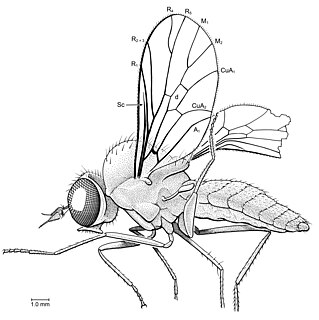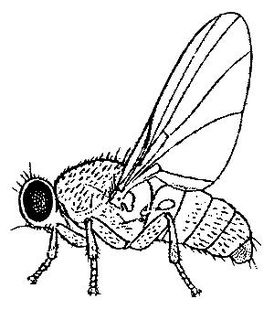
Flies are insects of the order Diptera, the name being derived from the Greek δι- di- "two", and πτερόν pteron "wing". Insects of this order use only a single pair of wings to fly, the hindwings having evolved into advanced mechanosensory organs known as halteres, which act as high-speed sensors of rotational movement and allow dipterans to perform advanced aerobatics. Diptera is a large order containing an estimated 1,000,000 species including horse-flies, crane flies, hoverflies and others, although only about 125,000 species have been described.

The Bombyliidae are a family of flies. Their common name are bee flies or humbleflies. Adults generally feed on nectar and pollen, some being important pollinators. Larvae generally are parasitoids of other insects.

Calyptratae is a subsection of Schizophora in the insect order Diptera, commonly referred to as the calyptrate muscoids. It consists of those flies which possess a calypter that covers the halteres, among which are some of the most familiar of all flies, such as the house fly.

Oestroidea is a superfamily of Calyptratae including the blow flies, bot flies, flesh flies, and their relatives.

The Asiloidea comprise a very large superfamily insects in the order Diptera, the true flies. It has a cosmopolitan distribution, occurring worldwide, with many species living in dry, sandy habitat types. It includes the family Bombyliidae, the bee flies, which are parasitoids, and the Asilidae, the robber flies, which are predators of other insects. Members of the other families are mainly flower visitors as adults and predators as larvae.

Mecoptera are an order of insects in the superorder Endopterygota with about six hundred species in nine families worldwide. Mecopterans are sometimes called scorpionflies after their largest family, Panorpidae, in which the males have enlarged genitals that look similar to the stingers of scorpions, and long beaklike rostra. The Bittacidae, or hangingflies, are another prominent family and are known for their elaborate mating rituals, in which females choose mates based on the quality of gift prey offered to them by the males. A smaller group is the snow scorpionflies, family Boreidae, adults of which are sometimes seen walking on snowfields. In contrast, the majority of species in the order inhabit moist environments in tropical locations.

Nycteribiidae is a family of the true fly superfamily Hippoboscoidea are known as "bat flies", together with their close relatives the Streblidae. As the latter do not seem to be a monophyletic group, it is conceivable not to unite all bat flies in a single family.

The Chironomoidea are a superfamily within the order Diptera, suborder Nematocera, infraorder Culicomorpha. This superfamily contains the families Chironomidae, Ceratopogonidae, Simuliidae, and Thaumaleidae. One of the more important characteristics used to define them is the distinctive form of their larval mouthparts.
Nannochoristidae is a family of scorpionflies with many unusual traits. It is a tiny, relict family of about eight species, with members of the genus Nannochorista occurring in New Zealand, southeastern Australia, Tasmania, and Chile, so is probably of Gondwanan origin. The adults look like scorpionflies with more pointed, elongated wings. Most mecopteran larvae are eruciform, or shaped like caterpillars. Nannochoristid larvae, however, are elateriform, or shaped like wireworm or click beetle larvae. They are also the only entirely aquatic Mecoptera. Wing venation suggests a close relationship to dipterans. They are predatory, primarily on the larvae of aquatic Diptera.

Boreidae, commonly called snow scorpionflies, or in the British Isles, snow fleas are a very small family of scorpionflies, containing only around 30 species, all of which are boreal or high-altitude species in the Northern Hemisphere. Recent research indicates the boreids might be more closely related to fleas than to other scorpionflies, which would render the order Mecoptera paraphyletic if the order Siphonaptera is excluded from it.

The Empidoidea are a large monophyletic superfamily of true flies, the sister taxon to the Muscomorpha (Cyclorrhapha). These two groups are sometimes united in the unranked taxon Eremoneura. There are some 10,000 known species within Empidoidea, which are represented on all continents except Antarctica. They are known to have existed since the Jurassic period.

Dolichopodidae, the long-legged flies, are a large, cosmopolitan family of true flies with more than 7,000 described species in about 230 genera. The genus Dolichopus is the most speciose, with some 600 species.

Empididae is a family of flies with over 3,000 described species occurring worldwide in all the biogeographic realms but the majority are found in the Holarctic. They are mainly predatory flies like most of their relatives in the Empidoidea, and exhibit a wide range of forms but are generally small to medium-sized, non-metallic and rather bristly.

Trichopezinae are a subfamily of empidoid flies. They are mainly predatory flies like most of their relatives, and generally small to medium-sized, long-legged and large-eyed.
Apystomyia is a genus of flies in the family Apystomyiidae. The genus contains the single living Apystomyiidae species, Apystomyia elinguis, which is primarily found in California. Details of its life history are largely unknown. The extinct genus Hilarimorphites is known from the Cretaceous Burmese and New Jersey ambers. Formerly placed in the Asiloidea, molecular phylogenetic studies in 2010 placed the genus unambiguously as a sister of the Cyclorrhapha within the clade Eremoneura.

Brachystomatinae is a subfamily of flies belonging to the family Empididae.

Panorpida or Mecopterida is a proposed superorder of Endopterygota. The conjectured monophyly of the Panorpida is historically based on morphological evidence, namely the reduction or loss of the ovipositor and several internal characteristics, including a muscle connecting a pleuron and the first axillary sclerite at the base of the wing, various features of the larval maxilla and labium, and basal fusion of CuP and A1 veins in the hind wings. The monophyly of the Panorpida is supported by recent molecular data.

Apystomyiidae is a small family of flies containing the living genus Apystomyia and the extinct genera Apystomima and Hilarimorphites. The single living Apystomyiidae species, Apystomyia elinguis, is native to California. Species of Hilarimorphites have been described from Mid to late Cretaceous Burmese and New Jersey ambers, while the single Apystomima species is from the Late Jurassic of Kazakhstan.

Fergusonina, the sole genus in the family of Fergusoninidae, are gall-forming flies. There are about 40 species in the genus, all of them producing galls on Eucalyptus, Melaleuca, Corymbia, and Metrosideros species in Australia and New Zealand.

Hymenopterida is a superorder of insects, comprising Hymenoptera and the orders of Panorpida . The superorder is a member of Endopterygota and most closely related to the orders of Neuropterida and Coleopterida.
















